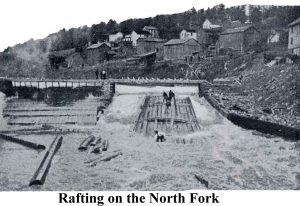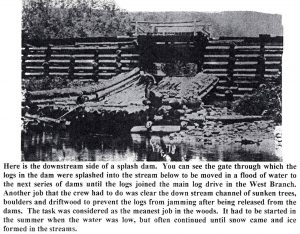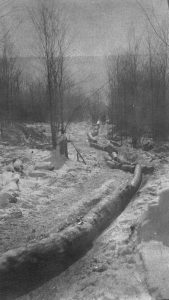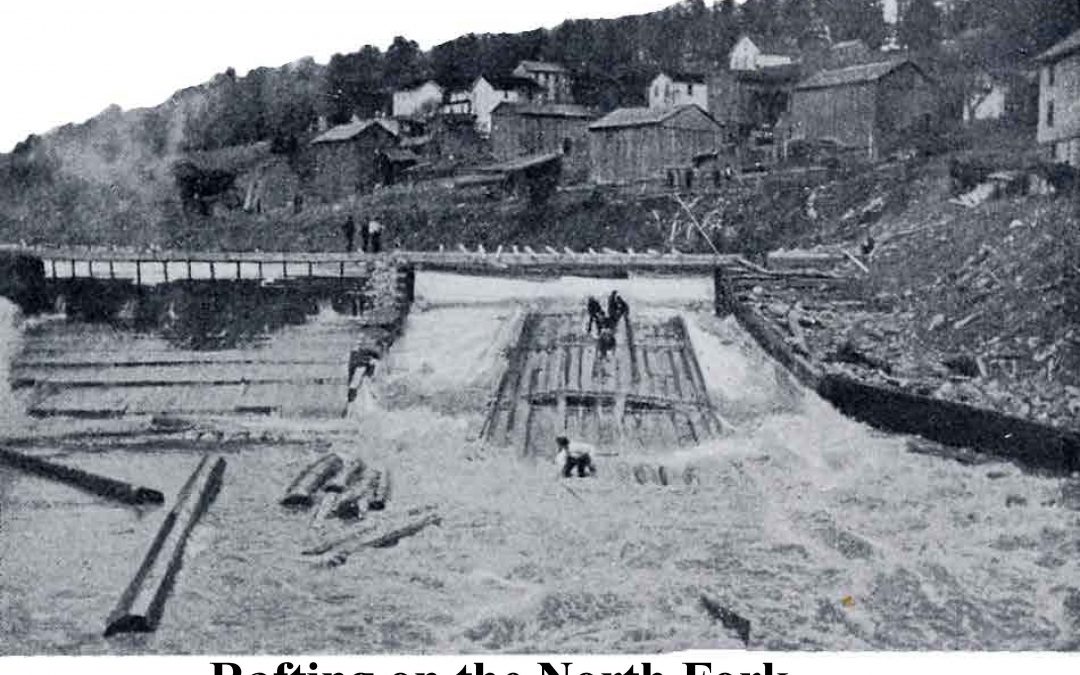By Bob Imhof

The lumbering industry was the major industry that built the wealth of Ridgway and most of Elk County. The Allegheny Plateau was blessed with a tremendous resource of tree species mostly conifers that were prized by the early settlers and people back on the East Coast for ship building, and various forms of construction, especially homes. In the early years of the industry our ancestors had to utilize the watersheds that crisscrossed the hills and valleys as the way of moving timber, thus when speaking about Ridgway, the Clarion River and its many tributaries became our “highway”. The most spectacular phase of the early Elk County lumber industry was the rafting of square timbers and lumber down the Clarion, Allegheny, and Ohio Rivers to Pittsburgh, Louisville, and New Orleans (outlined in the book True Tales of the Clarion River). For many years, a reckless breed of hearty men ran huge rafts at the fall of the flood downriver to the big cities along the Allegheny, Ohio, and Mississippi Rivers. Square timber is now a lost art, but from 1835 to 1910 thousands of square cut logs were hauled out of the woods of Elk County with horses and oxen, and made into rafts for the purpose of floating them down the Clarion River. ln the process, the logs had notches chopped in them. Then they were laid out, the face squared up, and the timber hewed smooth with a broad axe, most important to remember that the process was accomplished by hand. One of the most famous of the broad axe men was Harry Jefferson who resided in the Owl’s Nest section of Elk County. Mr. Jefferson was descended from hardy pioneer stock in the Lake City Section of Spring Creek Township. Two of his famous square cut logs stand as monuments to this historical era at Heart’s Content in Warren County and at the Pennsylvania Lumber Museum at Denton Hill near Coudersport in Potter County.
Rafting
Building rafts for transportation of lumber and huge log drives were the first uses of Pennsylvania’s extensive watersheds with the West Branch of the Susquehanna River being the greatest log drive river in the State. The average raft was 100 to 120 feet long and thirty to fifty feet in width. Square timbers were held together by saplings placed crosswise and held in place by ash bows and pins. Two huge oars at each end were used for steering. A short stocky post set into a timber at the rear of the raft was used to tie up the raft at the river’s bank. An agile riverman would leap from raft to shore, encircling a tree with a rope. A man on the raft would snub the rope on the post. Pilots as they were referred to were familiar with the river channel, were employed to guide the raft. Besides rafts of squared timbers, there were rafts of lumber-the product of Elk County’s early sawmills. Lumber rafts had heavy timber prows to protect the cargo from damage. Some rafts were equipped with shanties where the crews stayed during their trip downriver. Many pioneer women made the trip as cooks on shanty rafts. After entering the Allegheny River, two or more such rafts were fastened together for the trip down the river. Sometimes all or part of the crew left the raft at the Allegheny River, and walked back to their homes or camps. Later train service became available. ln other cases, the same crew would make the trip to Pittsburgh under the guidance of another pilot. ln the early heyday of lumbering, thousands of rafts made this run down the river. Most of square timber raft trips down the Clarion River ended after 1910, ending an amazing example of hard, dangerous work by our ancestors.
Splash Dams 
During the time prior to the development of the railroading systems that would provide the means to move raw materials (timber) to sawmills and markets it was up to ”lumber jacks” to find the way to move timber from the many remote valleys of Elk County to one of the many sawmills that dotted the county. With typical ingenuity and lots of hard work they developed a neglected part of Elk County’s lumbering history namely the “Splash Dam” era (1870-1900). Since some sections of the County were not yet opened to railroad transportation, there was a profound need to get logs from the remote valleys and distant plateau tops to sawmills that were many miles away. Despite the popularity of rafting logs, this method of log transportation was only desirable during the high-water period particularly in the spring of the year. Thus, splash dams become the best answer lo the problem.
Splash Dam Construction
A desirable spot on a major stream (not always) or small river was chosen to build the timber-crib earth type dam. Several acres or more would be cleared of trees and brush, and the earth pulled up by horse drawn pans to erect the breast work and fill the timber cribbing. Sometimes the cribbing spanned the full length of the dam across the valley. A large wooden gate that could be lifted quickly with a ratchet windlass mechanism or another hand means served to release the water through the spillway or chute when the dam was full. This created the “splash” or miniature flood that carried the logs down the stream channel to the sawmill or to a larger stream that had sufficient volume and depth of water to float the logs to their destination. Most of the logs would be piled along the shore below the dam in readiness for these splashes. Exactly how many splash dams dotted Elk County is unknown, but there were many. History records only some of them. During the many years I have explored the watersheds of Elk County, I have found many old splash remnants and not all of them were constructed using the process described above. Remnants of these old dam can be seen especially during low water levels in stream like Spring Creek above Hallton and along the Clarion River between Ridgway and Hallton as described in my brother’s book “Elk County: A Journey Through Time”
Log Slides 
“The log slide”, a means of quickly and easily transporting logs from the very steep slopes of the V shaped valleys of the Allegheny plateau to the stream, road, or railroad at the bottom of the valley was a device unique to this region. “A log slide was a shallow trough made by placing two logs or half-logs (half-rounds), to form a V shaped trough in which the saw log could be cradled. A series of these troughs were aligned to form a chute down an incline. The sections were spiked end to end and bedded on short cross members. They were commonly greased or during winter they were iced to allow the logs to slide easily. Logs were rolled (cant-hooked) onto the slide from skidways or dragged in by horse teams. Frequently teams were used to start the logs moving down the slope. Once they were moving down the often-steep incline, they developed speed. If they were shot into a stream, they were then floated (driven) to the mill pond by calkbooted river drivers. There were numerous log slides near Ridgway and surrounding streams including several in the Gallagher Run Valley. There was one on the end of Chestnut Ridge where it inclined down to the Clarion River south of Ridgway. Another was a mile above (East) of Ely’s sawmill on Elk Creek crossed the County road, present day Route 120 to St. Marys. There was no lookout or flagman. The only warning was a loud booming from up the mountain. It was dangerous to cross with horses. The horses instinctively knew the danger and were nervous when crossing the slide. This slide was operated by Sam Heeter, a logging contractor. He was a daring fellow who had a logging camp at the head of the slide. Once when his camp was ringed by a forest fire, he led his men in a running flight through the flames to safety. Heeter joined in the gold rush to the Alaskan Klondike in 1898. Many accidents occurred with the use of the log slides, and the danger was very real. For example, the following is a news item of December 13, 1888: “A horrible accident occurred near Daguscahonda last Friday morning in which Peter Flannigan and a team of horses were killed instantly. Charles Taylor and George Marvin were seriously injured. These men were working along the lower end of a log slide, Flannigan with his team being a distance above the others when a wildcat string of logs come down the slide with lightning rapidity. When near Flannigan, the logs jumped out, and hit him and his team and killed them. The other men heard the commotion and rushed up to see what was wrong. Just then a single log come whistling down, left the track, striking the men broadside. It is hoped they will recover.”



















